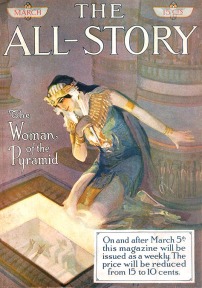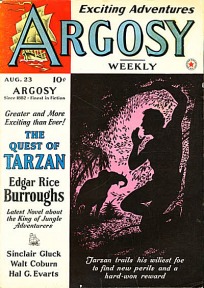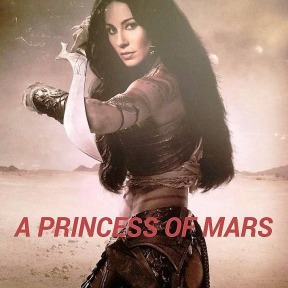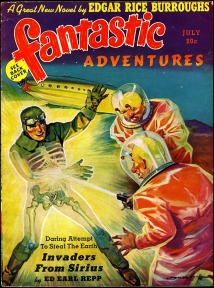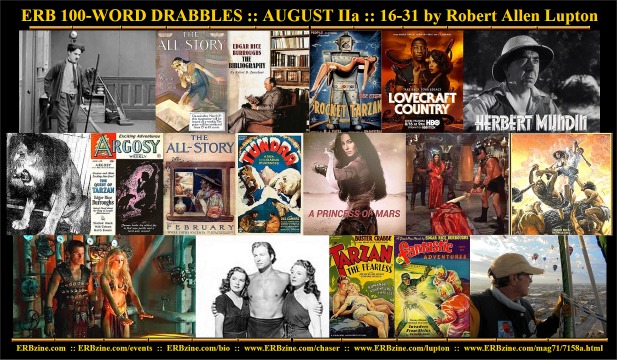
Official Edgar Rice Burroughs Tribute and Weekly Webzine Site Since 1996 ~ Over 15,000 Webpages in Archive Volume 7158a 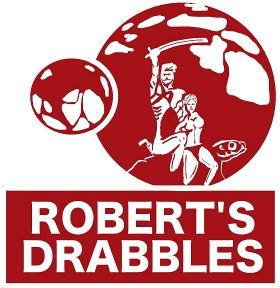 |
ERB 100-Word Drabbles
AUGUST IIa Edition :: Days 16 - 31
See Days 1 - 15 at ERBzine 7158
by Robert Allen Lupton
With Collations, Web Page Layout and ERBzine Illustrations and References by Bill Hillman
HIS MAJESTY, THE JANITOR
August 16: Was a busy day in Edgar Rice Burroughs history, visit https://www.erbzine.com/mag63/6341.html#AUGUST16 for a long list, but 105 years ago on this day in 1915, Edgar Rice Burroughs began a seven page synopsis titled “His Majesty, the Janitor. He finished it the next day. I haven’t been able to find a copy of the manuscript. Hopefully, it still exists and will see the light of day. Perhaps it will be published at a future Dum Dum or ECOF gathering. I hope so.
In light of the fact that the manuscript isn’t available, that leaves me free to speculate about the story. Perhaps a long forgotten and distant relative of a European ruler toils away as the janitor in a Chicago battery manufacturing plant. The old king dies leaving no heir and a massive search reveals the janitor to be the great-grandson of a princess, who fled the old country to wed her non-royal lover. Sounds pretty good. Charlie Chaplin or Lon Chaney Sr. would play the lead, depending on whether the director wanted to play the story for laughs or exiting adventure. I guess we’ll never know.
“The New Janitor” was the 27th Max Sennett film to feature Charlie Chaplin. Without seeing Burroughs script, it’s impossible to postulate any resemblance between Burroughs’ synopsis and the 16 minute Chaplin film – other than the fact that they both feature a janitor.
Today’s drabble was inspired by the title, “His Majesty, the Janitor.”
His Majesty, the Janitor
![]()
“Your schedule isn’t important. You’ll never mop another floor.”
“I’m I fired or are you my fairy godmother?”
“Neither, my good man. I’m the prime minister of an
European kingdom.”
“Sure, and I’m the king of Siam.”
“That’s close, Your Majesty. You’re actually the King
of Liechtenburg.”
Custer said, ‘That’s nice. Now move. The king can’t
have lunch until he finishes mopping this floor.”
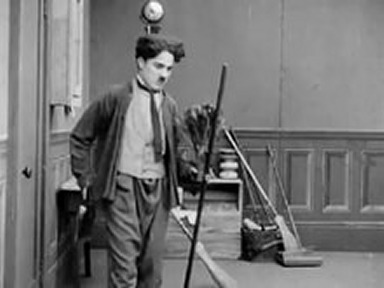
SMALL CONSOLATION
August 17: On this day in 1881, Frederic Charles William Small,.more commonly known as just Fred W. Small, was born on this date in San Francisco, California. He illustrated newspapers and pulp magazines. He was instrumental in first appearance of some ERB stories and his illustrations were often the first glimpse of what ERB characters looked like. He did the covers for The Warlord of Mars, The Beasts of Tarzan, The Mad King and The Cave Man (sequel to "The Cave Girl") and also "headpieces" for ERB's first pulp appearance: "Under the Moons of Mars" and such stories as "A Man Without A Soul" (part 1 of "The Mucker") and "Sweetheart Primeval," (part 2 of "The Eternal Lover")
In 1903, Small began illustrating the San Francisco Chronicle and by 1905 he was illustrated Sunset Magazine. Unlike most pulp artists, Small was working exclusively for Munsey magazines by 1915. His last pulp illustration was in 1921 – he accepted a full time job creating artwork to promote motion pictures.
For a detailed biography, visit : https://www.pulpartists.com/Small.html :: See more about Small and links to his ERB work in the ERBzine ERB Artist Encyclopedia --
https://www.erbzine.com/mag10/1016.html
“Small Consolation” is today’s Edgar Rice Burroughs and Fred Small inspired drabble.
Small Consolation
![]()
“No, “said Adolf Zukor. “I want a photo of Gary Cooper and Clara Bow.”
“Fred Small’s pulp magazine covers were amazing. He could still make a good living drawing those. We hired him, we should use him.”
“We use him a lot. What’s he gonna do, go back to drawing
pulp covers.”
“He might well do that.”
“Nah, we got a contract. It’s their loss. The pulps
are out of luck. It’s the pictures that got Small.”
CUT AND PASTE
August 18: On this date in 2016, "Edgar Rice Burroughs: The Bibliography," by Robert B. Zeuschner was published. This comprehensive work listing first and reprint editions of Edgar Rice Burroughs books, became available Aug. 18, 2016. The edition has 736 pages, and more than 600 images, 500 of which are in color on glossy stock.
This was a full-expanded, updated, and shortened title edition of his first bibliography -- "Edgar Rice Burroughs: The Exhaustive Scholar's and Collector's Descriptive Bibliography".
This is a beautiful volume with a wealth of information. This morning, Amazon listed one copy in stock – for $137.50. There were six copies, used and new, available from other sellers using the Amazon platform with prices ranging from $94.90 to $143.00 plus shipping.
The drabble today, inspired by Edgar Rice Burroughs and Bob Zeuschner is “Cut and Paste.” I actually have a book where someone pasted a wartime Tarzan book inside a different book's binding.
Cut and Paste
![]()
“Mine did too. It’s too bad Bob Zeuschner missed some editions.”
“I don’t think he missed anything.”
“There’s a mixed edition where a Grosset and Dunlap printing of the Warlord of Mars is bound inside the cover of an A. L. Burt edition of “Tarzan and the Apes.” He missed that.
“Never heard of it, John.”
“I know. Made it myself when I was ten years old.
I used a Star Wars comic book for the dust jacket. It’s one of kind.”
“And so are you, John.” See Less

GET IT RIGHT
August 19: This is the 800th article in this series. On this day on 1921, Gene Roddenberry, the creator of Star Trek, was born in El Paso, Texas. According to the Famous Kin website, Roddenberry and Edgar Rice Burroughs were 11th cousins, but that’s not why his birthday is mentioned here. In 1968, after relinquishing his Star Trek duties to Fred Freiberger. Roddenberry wrote a Tarzan script hoping to produce his own Tarzan film. The movie was never produced. It was deemed too expensive and allegedly contained many sexual oriented moments (people who have read Roddenberry’s script say that this is false).
Roddenberry wrote a letter dated June 7, 1968 to Tarzan film producer, Sy Weintraub outlining how he planned / hoped to film Tarzan. His vision was of a classical Tarzan. “Tarzan was best presented in the late 1800s in the "dark continent" mystique of Africa because contemporary Africa in the 1960s was very different and doesn’t have the deep jungles as imaged by Burroughs. Placing the film in this period also exuded a more "romantic" flavor than a Tarzan of contemporary times. Roddenberry admired the dichotomy of a savage man-beast who swung through the jungles that also learned to become comfortable in civilized society with the title of English lord. He preferred an "intelligent" man than Johnny Weissmuller's popular "Me Tarzan! You Jane!" dialogue, an interpretation that Burroughs himself hated!”
The movie poster presented is from the Hindi film, “Rocket Tarzan.” I thought it combined the worlds of Tarzan and Star Trek – with just a touch of “Forbidden Planet.”
The Drabble today, “Get it Right,” was inspired from a summary of that letter as reported by Frank Garcia in his article, “Gene Roddenberry’s Tarzan,” which can be read in its entirety at:
https://www.erbzine.com/mag0/0038.html#roddenberry
Get it Right
![]()
“Sy, the future belongs in the future and the past in the past.”
“I don’t know what that means.”
Present Tarzan realistically. He can’t swim faster than he can run. He knows the jungle. He wouldn’t be ambushed by a civilized hunting party. You destroy the “willing suspension of disbelief” criteria.”
“This from a man who splits infinities. To boldly go,
indeed.”
“Grammar aside, my characters are consistent.”
Consistency doesn’t mean box office longevity.”
“Time will tell for both of us.”
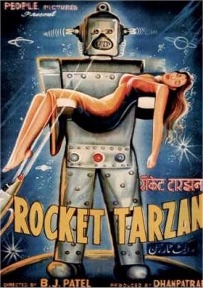
I SAY SHOGGOTH, YOU SAY SAGOTH
August 20: On this day in 1890, Howard Phillips Lovecraft was born in Providence, Rhode Island. A well-known writer today, there’s even a new television show “Lovecraft Country” on HBO. H. P. Lovecraft was virtually unknown during his lifetime. He was only published in pulp magazines while alive and he died in abject poverty. Lovecraftian Horror has survived to become a specific genre of fiction.
Lovecraft wrote a fan letter to All-Story Weekly that was published in the March 7, 1914 issue that featured ERB’s “The Eternal Lover.” From the letter it is obvious that Lovecraft was familiar with Burroughs’ work and he later used several elements of Burroughs’ fiction in his own stories. Lovecraft was somewhat critical of ERB in the letter.
https://www.erbzine.com/mag11/1137.html
HPL used the a lot of the Pellucidar mythos – a reptile race, underground tunnels, a hollow Earth with eternal daylight, prehistoric creatures, superior “Old Ones,” an winged race who controlled their minions, the Shoggoths, and kept men like farm animals. (At the Mountains of Madness)
Two other striking similarities include “The Silver Key” wherein Randolph Carter experiences an out of body experience while in a cave, and “Arthur Jermyn” features pterodactyls, gigantic drilling machines, and subterranean worlds. Who knew that besides his creation of Cthulhu Mythos, Lovecraft may also have been the creator of FanFiction.
“I say Shoggoth, you say Sagoth” is today’s Edgar Rice Burroughs and H. P. Lovecraft inspired drabble.
I say Shoggoth, you say Sagoth
![]()
“I read it, Joan. Lovecraft tries to write like long dead Englishmen. That writing style was out of date before he was born. People won’t read his stuff.”
“I don’t know about that. He appeals to ancient embedded memories and fears passed down for generations. He evokes unnamed and unspoken dreads."
Lovecraft said, “Almost nobody dances sober, unless they’re insane. I suspect he writes the same way.”
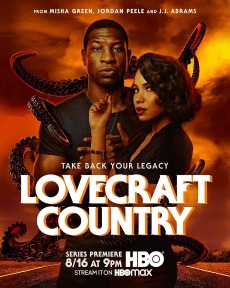
I'LL DRINK TO THAT
August 21: On this day in 1898, Herbert Mundin was born. The comic actor is best known for his portrayal of Much, the miller’s son in “The Adventures of Robin Hood.” During his career, he also appeared in “Chandu the Magician, ”Sherlock Holmes (1932), “Orient Express” (1933), and ‘Mutiny of the Bounty.”
He was added to the cast of “Tarzan Escapes” for comic relief. Initial reviews indicated that the movie was too violent and terrifying. The original version of this film, titled “The Capture of Tarzan,” was shown to preview audiences in 1935 and was heavily criticized for scenes of gruesome violence. The most notorious scene was one involving a giant bat attack in a swamp. Hollywood legend has it that, at the preview showing, the sight of these giant creatures carrying off panic-stricken porters sent kids screaming from the theatre. So strong was the negative reaction from parents, critics and the media, that the studio ordered much of the film re-shot. MGM replaced the original director, James McKay, with a series of directors with the final credit given to Richard Thorpe.
In addition to the addition of Mundin, the vampire bat scene was cut from the final version of the picture. Mundin was cast as Jiggs Rawlins, the minion / assistant to Captain Fry, played by John Buckner. This was Buckner’s last film. He died in a car crash after filming was completed, but before the picture was released. In a strange twist, Herbert Mundin was killed in an automobile accident himself, barely three years later. It was rumored that Herbert was the only man who could outdrink Errol Flynn. Bottoms up, mate!
Today’s drabble is inspired by Herbert Mundin and Edgar Rice Burroughs. It’s called “I’ll Drink to That.”
I’ll Drink to That
![]()
“I bumble with the best. In my avocation, I see many
strange things.”
“Your avocation? I thought you were an actor.”
“Well,” said Herbert Mundin, “that’s close, but it’s
not entirely true. I’m actually a professional drinking man with a bit
of an acting problem.”
Thorp replied, “I’d heard you were an alcoholic.”
“Not true. I’m a drunk. Alcoholics have to go to those
damn meetings.”
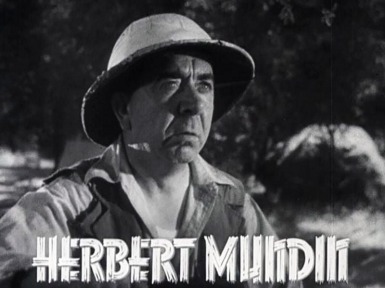
DOING WHAT COMES NATURALLY
August 22: On this day in 1937, the article “Man-Eaters,” appeared in the Sunday supplement of the Los Angeles Times. Written by Edgar Rice Burroughs the article explored the erratic behavior of lions.
The LA Times blurb for the article said, “Unpredictable." That's what the father of Tarzan has to say about lions -- and cites facts that will chill your blood to prove it.”
The entire article has been transcribed by Bill Hillman and is available to read in its entirety at https://www.erbzine.com/mag0/0071.html .
The photo included with this post is from the article.
“Doing What Comes Naturally” is today’s Edgar Rice Burroughs inspired, actually written, drabble. It is taken from that article.
Doing What Comes Naturally
![]()
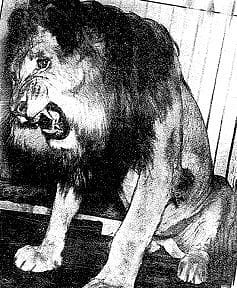
GOOD GLUCK
August 23: On this day in 1941, Argosy Weekly published the first installment of “The Quest of Tarzan.” ERB began writing "The Quest of Tarzan" in November, 1940. Along with “Tarzan and the Champion” and “Tarzan and the Jungle Murders,” “The Quest of Tarzan” was first published in book form in hardcover by Canaveral Press in 1965. At that time "The Quest of Tarzan" was re-titled "Tarzan and the Castaways" to avoid confusion with the earlier Tarzan novel “Tarzan's Quest.’ The first paperback edition was issued by Ballantine Books in July, 1965.
The Argosy Weekly issue was graced with a Virgil Finlay cover illustration for “Quest of Tarzan.” The issue contained an olio of other stories including “Bunny Rabbits” by Don Tracy, “Swords in Exile” by Murray R. Montgomery, “No Ticket to Nippon” by Sinclair Gluck, and “Colonel Collie” by Hal G. Evarts. Prior to WW1, Gluck novelized a number of silent Hollywood melodramas under the name Melrod Danning. He wrote the novelization of Mary Pictfords, “The Foundling.” Gluck had a long career and lived until 1956, but his story, “No Ticket to Nippon,” appears to be his last new work.
Today’s Drabble is ‘Good Gluck,” and it’s inspired by Edgar Rice Burroughs and his fellow contributors to this issue of Argosy Weekly.
Good Gluck
![]()
“They’ve kept the price at ten cents, but made the book smaller. When we join the war, I expect the weekly to go monthly and the price to go up.”
“Will you make less?”
“Other writers will take less or retire. Hopefully, that allows my pay rate to stay the same.”
Hulbert asked, “Who’s retiring?”
“Sinclair Gluck wrote and said that he might retire to Dublin. He always had the Gluck of the Irish.”
August 24: On this day in 1911, Thomas Newell Metcalf, the editor of The All-Story Magazine mailed a tentative letter of acceptance for “Dejah Thoris, Martian Princess,’ later titled “Under the Moons of Mars,” later even later retitled “A Princess of Mars.” Metcalf asked Burroughs to finish the story and hold the entire book to under 70,000 words. He also said that he was holding the manuscript awaiting instructions from ERB.
Burroughs wrote back two days later and enclosed ten cents to pay the postage to have his the manuscript returned.
Thankfully, ERB finished the story, maintained the expected length, and Metcalf bought it. The first of six installments was published in the February 1912 issue of “The All-Story Magazine.” The cover appears to illustrate the story, “The Serenade,” by Edward Coate Pinkley.
The entire letter can be read at https://www.erbzine.com/mag28/2832.html
Today’s drabble, “Shorter is Better,” written by Thomas Metcalf and absolutely inspired by Edgar Rice Burroughs is taken from that letter.
Shorter is Better
![]()
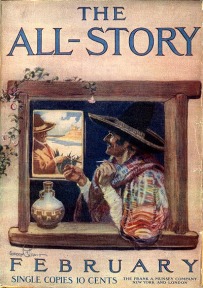
THIS BED IS JUST RIGHT
August 25: On this day in 1936, “Tundra,” a film produced by Burroughs-Tarzan Pictures (Edgar Rice Burroughs and Aston Dearholt) was released. In 1949, RKO Pictures re-edited, retitled the film “Arctic Fury,” and re-released it. The film was directed by Norman Dawn, who also wrote the story outline. The screenplay was credited to Charles F. Royal and Norton S. Parker. Alfred Delcambre, Merrill McCormick, Jack Santos, Frank Baker, Earl Dwire, and Wally Howes were featured. Aston Dearholt was one of the four credited producers.
Merrill McCormick played two roles in “The New Adventures of Tarzan.” He played Bouchart in chapter one of the serial and Lopez ins Chapter 11.
Rotten Tomatoes has this to say about the film. “Del Cambre plays an airborne doctor who crashes in the frozen wastes while transporting medicine. His life is saved by a pair of mischievous bear cubs, whom he "adopts." After six reels of scenery, the filmmakers return to the plot, with Cambre tackling an epidemic in a remote Alaskan village.”
Video tapes of the film are available for purchase from time to time one various websites and is available to watch on Amazon Prime Video at: More about TUNDRA in ERBzine's ERB: FILM PRODUCER
https://www.erbzine.com/mag2/0287.html
https://www.erbzine.com/mag2/0287a.html
Today’s drabble inspired by the film and by Edgar Rice Burroughs is called, “This Bed is Just Right.”
This Bed is Just Right
![]()
Doctor Barlow said, “My plane crashed. I’ve walked four hundred miles carrying my equipment.”
“A city boy like you! You should have frozen to death.”
“I found two young polar bears. They taught me how to find food and water. We dug shelters in the snow and ice and huddled together to keep warm. The temperature was just right.”
“You’re saying that two baby bears taught you to make
igloos?”
“Interesting,” said Doctor Barlow. “I never considered
calling them igloos. I thought of them as cubbyholes.”
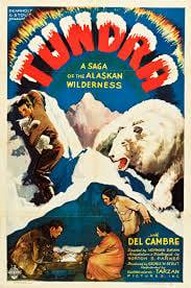
SHOW ME THE MONEY
August 26: On this day in 1911, Edgar Rice Burroughs replied to Thomas Newell Metcalf thanking him for his interest in the unfinished manuscript, Dejah Thoris, Martian Princess. Newell bought the story once Burroughs completed it and published it in The All-Story Magazine using the title “Under the Moons of Mars."
In the letter, Burroughs supplied an outline for the unfinished portion of the manuscript.
Read the entire letter at: https://www.erbzine.com/mag28/2832.html
“Show Me the Money” is today’s drabble. It is excerpted from Burroughs letter on 26/08/1911.
Show Me the Money
![]()
“I wrote this story because I needed the money it might bring, and not from motives of sentiment, although I became very much interested in it while writing. I’m therefore open to suggestions about what parts you consider to be unessential.
Please tell me what remuneration I may expect for a story of sixty to seventy thousand words, and when payment would be made if the story was available.”
KILL ME, PLEASE
August 27: On this day in 1977, the film “The People That time Forgot,” was released by Amicus Productions. The film, released barely three months after the first Star Wars film, was based on the Edgar Rice Burroughs novel of the same name and was 91 minutes in length. The difference in the production qualities of the two films, basically film at the same time, is apparent to the most casual observer.
The movie was directed by Kevin Conner and starred Patrick Wayne, Doug McClure, Sarah Douglas, and Dana Gillespie. There are some notable differences between the book and the film. The lost world becomes a polar continent rather than an island. Bowen Tyler dies in the film and Lys is dead before the film begins. The book ends with two marriages – the movie with none.
Sarah Douglas, who played Lady Charlotte “Charlie” Cunningham in the film is best known for playing the villain, Ursa, in Superman and Superman II. Numerous Frazetta paintings decorate the walls in scenes throughout the movie. David Prowse, who played Darth Vader appeared in the film as the “Executioner.”
“Kill me, Please” is today’s Edgar Rice Burroughs and Amicus Productions inspired drabble.
Kill me, Please
![]()
“Yeah, it was me. They hated my accent and dubbed all my lines.”
“You have no lines in this film.”
“Doug, do you think we’ll get parts in the next movie in this series?”
‘Don’t think there’ll be a next film. I’ve seen Star Wars and I’ve seen our dailies. Our production quality is light years behind. It’s 1977 for God’s sake. This film will die quicker at the box office than I thankfully do in my final scene.’
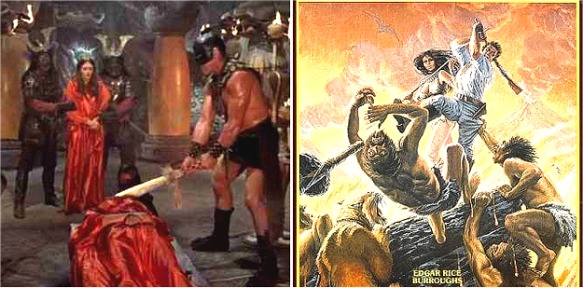
KILL THEM ALL
August 28: On this day in 1911, Thomas Metcalf returned “Dejah Thoris, Martian Princess” to Edgar Rice Burroughs for revisions and completion. I’m personally glad that ERB didn’t follow Mecalf’s suggestions. He recommended that Dejah Thoris die of disease and that after her breath John Carter return to Earth dying of the same sickness. Yuck.
Read Metcalf’s letter at: https://www.erbzine.com/mag28/2832.html
Today’s drabble, “Kill Them All,” is taken directly from Metcalf’s letter dated August 28, 1911.
Kill Them All
![]()
It’s customary for us to buy serial rights from five to ten dollars per thousand words, but I cannot tell you anything definite about this.”
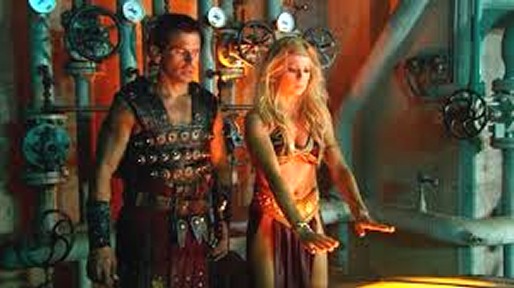
WHO WANTS ICE CREAM
August 29: On this day in 1985, Evelyn Felisa Ankers, who appeared with Lex Barker and Brenda Joyce in “Tarzan’s Magic Fountain,” died from ovarian cancer. Ankers was born to English parents in Valparaiso, Chile, and became an American citizen in 1946.
She was one of the several actresses given the title “Queen of the B’s” and her claim was as strong as most. Her films included, “The Wolf Man” (1941), “The Ghost of Frankenstein” (1942), “Captive Wild Woman” (1943), “Son of Dracula “(1943), “The Mad Ghoul” (1943), “Jungle Woman” (1944), “Weird Woman” (1944), “The Invisible Man's Revenge” (1944), and “The Frozen Ghost”(1945). She appeared in “Hold That Ghost” (1941), “Sherlock Holmes and the Voice of Terror” (1942), “His Butler's Sister” (1943), “The Pearl of Death” (1944), “Pardon My Rhythm” (1944). Once engaged to Glenn Ford, she married actor, “Richard Denning.”
The drabble for today, “Who Want’s Ice Cream?” is taken from a quote by Evelyn Ankers, who made several films with Lon Chaney Jr., whom she disliked and called “The brute with bad breath.”
Who Wants Ice Cream?
![]()
Dick replied, "It's a lot better than not being in the service during wartime"--which was Lon's situation.
Lon said, "I've got a little ice cream on my sleeve", and wiped it on Dick's dress blues. Dick took his ice cream, pistachio green, and pushed it in Lon's face. With that green dripping from his face, it looked like monster make-up.”
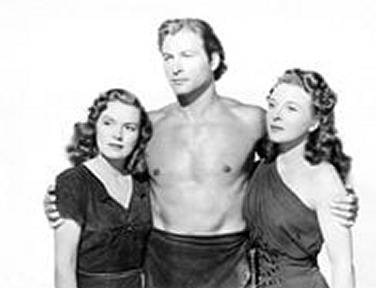
WHAT'S MY NAME
August 30: Julie Bishop, an actress known professionally as Jacqueline Brown, Jacqueline Wells, and Diane Duval, was born on this day 106 years ago in 1914 and died 19 years ago on her birthday in 2001. She played Mary Brooks, the female lead, opposite Buster Crabbe in the serial, “Tarzan the Fearless.”
Her earliest talkies were with the Hal Roach studio, where she worked in short-subject comedies with Laurel and Hardy and Charley Chase. Then she began freelancing, working in supporting roles at large studios and in leading roles at small studios. She made 16 films at Warner Brothers , including supporting roles in “Action in the North Atlantic” (1943) with Humphrey Bogart and “Princess O'Rourke” (1943), starring Olivia de Havilland and Robert Cummings. She was Errol Flynn's leading lady in “Northern Pursuit” (1943), played Ira Gershwin's wife in the biopic, “Rhapsody in Blue “(1945), and closed out her Warner years in 1946's “Cinderella Jones.”
In 1949, Bishop played a down-on-her-luck wife and mother in the “Sands of Iwo Jima,” opposite John Wayne. She changed her performing name to Jacqueline Brown because it matched the initials of her married name, Jacqueline Brooks, on her luggage.
“What’s My Name” is today’s drabble.
What’s My Name
![]()
“Well, a girl’s got to work. Thank you.”
“You’ve made over eighty movies, haven’t you?”
“Eighty that people know about, I made a lot of silent short films and used a lot of different names. Studios in the old days wanted exclusive contracts. A little make up and a name change here and there and I could work for several at the same time.”
“Julie, how many different names did you use?”
“That’s not a question that a gentleman asks. It’s certainly not one that a lady answers.”
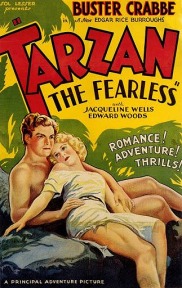
NOT YOUR BEST WORK
August 31: On this day in 1922, Edgar Rice Burroughs finished writing “Beware.” The 22,000 word story suffered a major rewrite at the hands of Ray Palmer before it was published in “Fantastic Adventures” in July of 1939. The Burroughs Bulletin published the story as originally written by ERB (under the name Tyler McCulloch) in July 1974. ERBdom published a reduced photographic reproduction of “Scientists Revolt (Palmer’s version) in issues #42, #43 and #44. The Burroughs Bulletin published the Palmer version in issue #40 in 1974.
Back in August 1922, Burroughs finished dictating “The Moon Maid” on his Ediphone and wrote “Beware" directly on a typewriter.
“Beware” centers on the political intrigues in the small European kingdom of Assuria. Burroughs submitted the story to Bob Davis at Munsey’s (All-Story), who rejected it saying, “I think Beware is the nearest approach to mediocrity that ever came from your pen.”
The story was rejected by Blue Book, Detective Tales, and Weird Tales. In 1929, Weird Tales offered $230.00 and Burroughs declined. He sold the story to Fantastic Adventures in 1939 for $245.00. Palmer changed the story from one of political intrigue in post WW1 Europe to a science fiction novel taking place in 2190.
"Beware" was not my favorite ERB story - either version, but you should both stories and decide for yourself. Free to read at:
https://www.erbzine.com/mag52/5233a.html
Not Your Best Work
![]()
“Yes, I did. Are you sending an acceptance letter?”
“Oh, hell no. The story doesn’t even have an ending. The only person who knows whether or not Donovan is the crown prince is in a coma.”
“I’m leaving room for a sequel.”
“God give me strength. You crammed New York, Russians,
crown princes, grand dukes, and spies into this one. Will you put Tarzan,
John Carter, and Dejah Thoris in the sequel?”
“Great idea. I can do that.”
“Please don’t. I should beware what I wish for.”
![]()
See
Days 1 - 15 at ERBzine 7158
![]()
AUGUST IIa ILLUSTRATIONS COLLAGE
![]()
